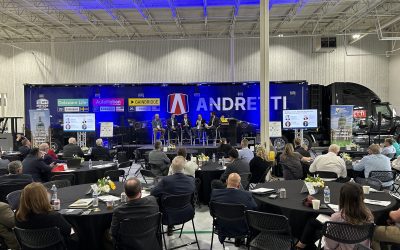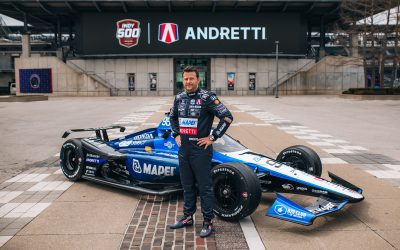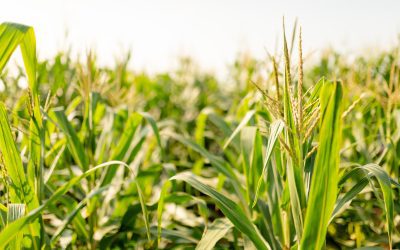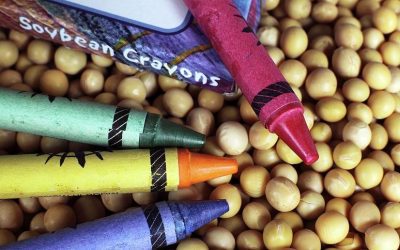Shortly after Gary Lamie’s death in 2013, the Indiana Corn Marketing Council (ICMC) remembered the Tippecanoe County farmer’s contributions by naming a Purdue University scholarship after him.
Lamie – ICMC president in 2013 and a key player in establishing the state’s corn checkoff program – was known by his efforts to explore new uses for corn, helping fellow growers. This drive lives through the annual $50,000 scholarship that has funded Purdue College of Agriculture’s Graduate Student Corn Research Assistantships for almost a decade.
Dr. Bernie Engel, associate dean and director of agricultural research and graduate education in Purdue’s College of Engineering, and ICMC put out the call each January for master’s and doctoral degree students working in corn research. The university and ICMC review applications and, in the summer, Engel’s office narrows these to two students who will receive $25,000 each to help support their research and living expenses for a year.

He has filled this role for three years, and he and the ICMC board look for highly qualified graduate students working on corn-related issues. “And then, it’s really about trying to understand the potential impact they may have as future leaders within industry, within government agencies, even back on a farm,” he explained. “How are they going to impact the corn industry as we think about the future?”
Last year fewer than 10 applicants threw their hat in the ring, but he noted the final two is always a difficult decision since applicants are all top students whose projects often intersect with ICMC goals. In 2021, his office selected PhD candidates Ana Morales-Ona and Seth Tolley. The two recently filmed individual short video presentations for the ICMC board to summarize their year of research.
Engel said the focus of each candidate is unique, but they do share a common thread of using UAV (unmanned aerial vehicle, or drone) imaging as part of their toolkits. Tolley’s work in part focuses on measurements to help select corn varieties to breed for future yields, and Morales-Ona’s examines how imaging can be refined to measure corn health in the field and identify problems such as disease in order to mitigate them earlier.
Drone data challenges
Morales-Ona noted research she has worked on for the past year is part of a larger on-farm project on nitrogen use efficiency and the methodology for determining use. She has been examining fields in five counties in north, southcentral and eastern Indiana. While she collected most of her own data, she also drew from data sets amassed by two professors – Dr. Jim Camberato, an extension soil fertility specialist, and Dr. Bob Nielsen, aka “the Purdue Corn Guy.”
She explained UAVs are an important tool for agronomic research, as they allow a bigger overview of a field and can be mounted with different sensors that help focus scouting work. Corn plants interact with sunlight in different ways depending on their health, which is the basis for NDVI near-infrared (NIR) imaging. The Normalized Difference Vegetation Index is a mathematical formula that uses both NIR and visible light reflected by plants to determine plant-growth density and health.
Her work has included making NDVI data more efficient by determining when imaging benefits from “masking,” or removing unneeded background image data such as soil and plant shadows. This can be used toward corn yield prediction and to assess the effects of fertilizer treatments – the goal is to use known sensor information as inputs for future crop modeling.
“We can use them to do simulations,” Morales-Ona explained. For instance, what would be the yield in a cornfield at different temperatures? With different soil? With different seeding rate?
And while UAVs are great tools to search for problems in a planted field, they won’t fully replace on-ground crop scouts, as evidenced by her own in-field work. “At least it can help us to be more efficient to know where to go” in the field to look for plant problems, she noted, “instead of just going around the field without a specific objective.”
On the ground, Morales-Ona said her work should help farmers make sooner and better decisions about their crop in the short term when they can get data faster and more efficiently. Long-term, she can assess regions around the state on their soil, weather and management practices – also with the goal of advising farmers on crop planning.

Her doctoral advisor at Purdue is extension corn specialist Dr. Daniel Quinn; she previously completed her master’s program at Purdue under Nielsen and Camberato. She first came to Indiana in 2017 as a visiting scholar from her home country, Ecuador, having earned her bachelor’s degree in 2014 from Universidad Zamorano, an agricultural institution in Honduras.
Continuing yield goals
Tolley is actually a “three-peater,” first approved for the Lamie scholarship in 2020, again in 2021 – and yet again into 2023 (along with master’s candidate Brendan Hanson, whose work focuses on nutrient partitioning in corn under differing environments and inputs).

With the first scholarship, Tolley extended his PhD research working with phenotyping technology and UAVs to collect plant data and using ear photometry for phenotyping. During the growing season of 2020, he monitored growth and development of corn using specific reference measurements; and used photometry to assess yield components such as kernels per ear, length of ear and kernel weight.
Seed companies use this kind of technology to develop greater-yielding hybrids, and he wanted to validate and demonstrate their utility.

In the past year, Tolley said he brought more specific genomic data into this process, to integrate with phenotyping toward yield prediction. Three of the studies in his video to the ICMC board included heterotic patterns of temperate (common to the Midwest) and tropical maize by ear photometry; multi-trait genomic prediction of grain yield on a plot and ear basis; and row selection in remote-sensing in both corn and sorghum.

His long-term project is to integrate remote sensing, ear photometry and genomics for yield prediction. He explained the tools and techniques need to be assessed for use in improving genetic gain in corn breeding programs, and studies such as his can be used to inform commercial breeding. “He is tremendous,” Engel said of Tolley’s research being chosen three years in a row as a Lamie recipient.
Tolley likes that his research has afforded him opportunities to work with scholars in disciplines outside of crop sciences at Purdue, such as in engineering and animal sciences.

After earning a bachelor’s degree at the University of Illinois-Champaign in 2017, he transferred to Purdue and completed his master’s program in 2019 under advisor Dr. Mohsen Mohammadi, who specializes in wheat breeding and quantitative genetics. His doctoral advisor is Dr. Mitchell Tuinstra, Wickersham Chair of Excellence in Agricultural Research.
“I like the work that I’m doing a lot right now, but ideally I’d like to move over into industry and continue to work on the projects I’m doing now – just in a commercial space,” Tolley said of his post-doctoral plans. “The primary goal (of this research) would be that these methodologies would be used in breeding programs, and would result in greater yields for farmers, at the end of the day.”
Plowing forward on research
He noted of the Lamie scholarship, “It’s made it so I haven’t had to worry about financial support … and with it, I think we’ve been able to use a few more remote sensing applications, as well.”

The scholarship funds half the recipients’ working time through the year, Engel said. It also helps finance their attendance at a professional meeting in their field of study so they can present their findings to and network with future colleagues. Those receiving the scholarship have completed their coursework and chosen a research focus at the time of selection, but they still have leeway to work out their specific methodology over the following year.
And while Engel’s office, with the ICMC board’s support, typically tries to select one master’s and one PhD candidate each year, it’s not a rule – as evidenced by last year’s two doctoral recipients.
Engel pointed out not every recipient comes from a farming background, but Morales-Ona and Tolley each do in different ways.
Tolley grew up on a corn, soybean and cattle farm near Avon, Ill., where his parents and brother continue to work. He took an early liking more to the plants than the animals, “so it was kind of a natural fit to go into agronomy.”
In an interview last year, he explained, “I think plants are fascinating; it is incredible to me that a single kernel of corn can produce an ear with over 600 kernels.”

Morales-Ona is a city girl from Quito, the capital of Ecuador – but her grandfather, Pablo Ona, had a farm about an hour away. “I wanted to know more,” she said. “When you grow up in a city, you’ve got a lot of questions about farming. I used to have a lot of questions. ‘How does this happen?’ and ‘How is this grown?’”
Ona passed two years ago, but she said he was excited about her studies, as she was the only one of 16 grandchildren to go into agriculture. Working with growers now reminds her of learning from him, and her postdoctoral goal is to stay in academia as a crop extension specialist.
“I love extension and interacting with farmers and crop advisors, and learning from each other,” Morales-Ona said, adding she would like to mentor future students as well.

Engel explained ICMC’s support is about more than financing one study for one year – it’s a long-term investment in the industry. “What (ICMC members are) really doing is supporting good research that’s relevant to Indiana farmers, and second, as a result of that, they’re really supporting someone who’s hopefully going to stay in the state or the region, who’s going to be a leader in the industry of corn.”



